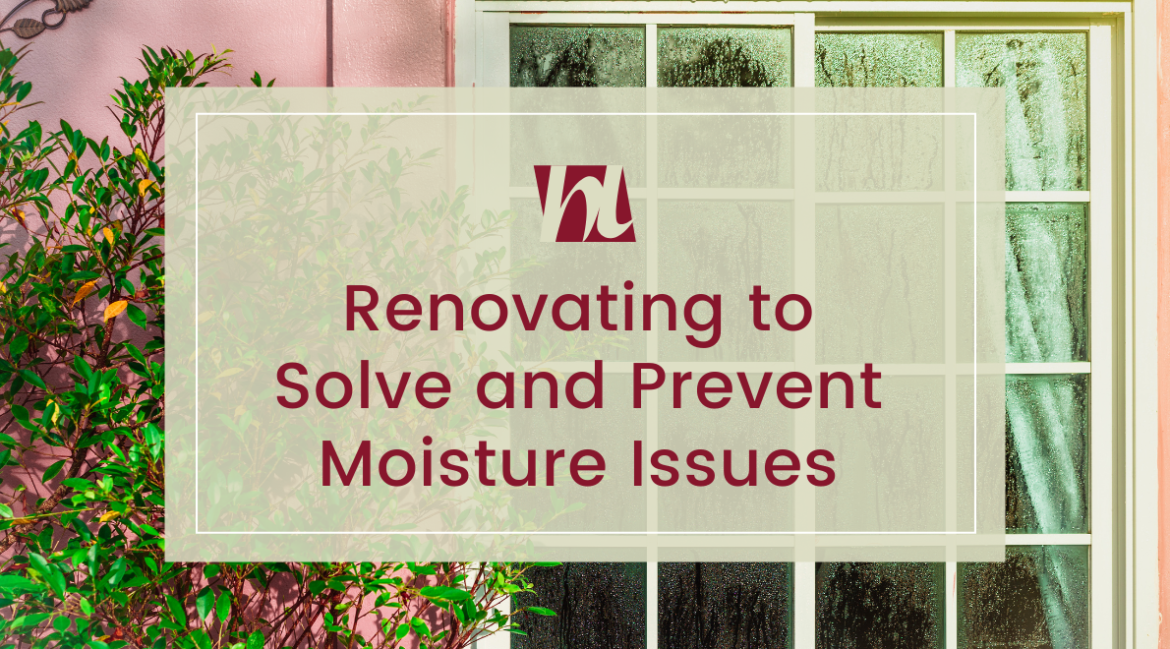Renovating to Solve and Prevent Moisture Issues
There are clear signs when you have excess moisture in your home. Sometimes, simple changes can reduce the amount of moisture. Other times, more major renovations may be required to make your home safer and more comfortable. Take care of excess moisture issues as soon as possible with a complimentary consultation with the House Lift team.
What are the signs of moisture in my home?
Excess moisture in a home shows up in many different ways. One of the more obvious signs of too much moisture is condensation on your home’s windows, especially in the colder months. You may see the telltale spots of mildew or mold growing in your bathroom or in the corner of a closet or the kitchen. Mold in your basement is another sign. Peeling, cracking, or blistering paint can also indicate a moisture issue.
What are the forms of moisture?
There are three states of moisture: solid (ice), liquid (bulk water), and gas (airborne moisture or vapor). All three can affect your home. Ice is typically found on the exterior of your home in the form of ice dams, which can cause water to leak into the interior. If your windows are in poor condition, condensation forming on the inside can turn to ice, too.
Bulk water is obvious because it is usually the result of a leak, often through poor flashing on your roof or a porous basement wall. However, bulk water can also appear as the result of condensation, which forms when warm moist air comes in contact with a cold surface, such as an uninsulated or poorly insulated roof. Airborne moisture is the most elusive of the three states, since you cannot see it until it turns to bulk water through condensation or moistens building components and forms mold.
Where’s the moisture in your home coming from?
We often accidentally produce excess moisture inside our homes just by living in them. This may occur when we’re cooking or baking, or when we use a humidifier to make the air in our homes more comfortable. Forgetting to turn on the exhaust fan in the bathroom when you shower can also create excess moisture.
Other times, there’s an underlying issue with your home’s walls, roof, or mechanical systems that leads to excess moisture. Many homes, especially older ones, have leaks around windows and doors that may allow airborne moisture, rain, ice, and snow to enter walls, ceilings, or the attic. These leaks can cause a mildew or mold issue that affects the air quality and safety of your home as well as more acute issues such as soaked drywall and insulation, or even rotting wood structure. Additionally, in Minnesota, ice dams can create a big mess in your home’s eaves and along exterior walls and ceilings.
Improper ventilation can also cause excess moisture, either by not allowing moisture to escape the home or by drawing moisture-laden air into the home.
How can renovations reduce moisture in your Minnesota home?
To maintain safe and comfortable relative humidity levels in your home, there must be an exchange of outdoor and indoor air. Most homes accomplish this through exhaust ventilation that allows air to escape through kitchen or bathroom vents in the roof or wall. There are also more robust ventilation systems, such as HRVs or ERVs. Without these essential systems, moisture may become trapped inside the home and create mildew, mold, and structural damage.
Remediating moisture issues in your home
There are four basic components to the remediation of moisture in your home:
- Proper air sealing, both from outside to inside as well as within your home. For example, seal the air bypasses from your living areas to a cold attic to prevent warm, moist air from reaching the cold roof surface.
- Proper insulation is key to comfort as well as preventing moist air from entering your home.
- Waterproofing roofs, walls, and basements to prevent the entry of bulk water.
- Proper ventilation. Both too little ventilation and too much ventilation can create moisture issues in your home. A more balanced system may be required to properly deal with moisture levels. Keep in mind the saying, “build it tight and ventilate it right.”
Updates to your home’s windows and doors can rebuild the seals that protect your home from the elements, especially if your windows and doors are original to the house. Modern door and window products are more energy-efficient than older ones. When properly installed, they will protect your walls, ceiling, and attic from excess moisture.
Choosing an experienced contractor
If moisture is an issue in your home, an inspection can tell you if your home’s ventilation system needs updating. Protecting a home against excess moisture takes experience and expertise. Good design and properly installed windows and doors prevent excess moisture from taking place in the home. When you partner with House Lift, our professional team will take the time to understand your home and your needs so we create a solution that will work beautifully for your family and protect your home from excess moisture.
Get in touch with the House Lift team today to request your complimentary consultation.


No Response